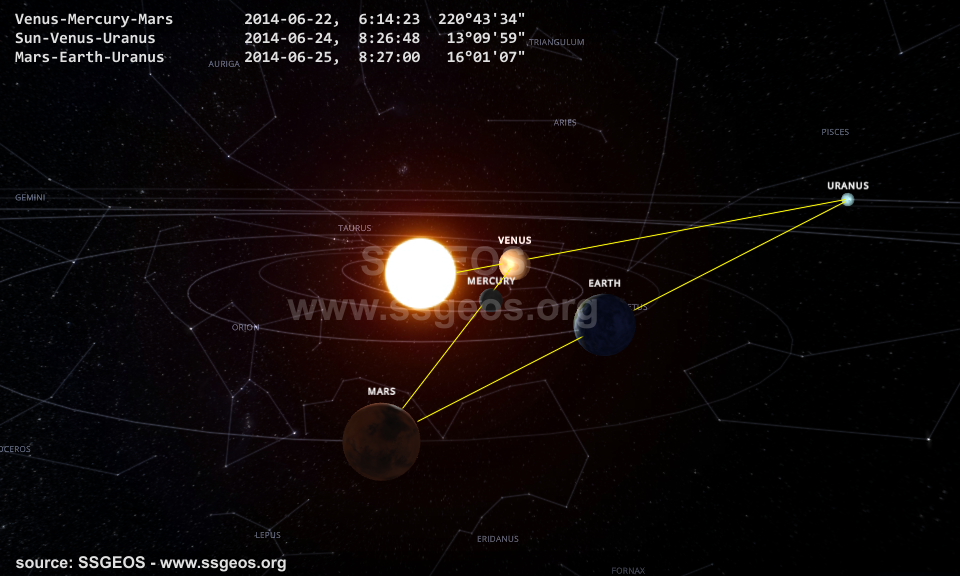Electromagnetic Wave - Earthquake Mechanism
updated 18 April 2025
The gravitational force as described in classical mechanics has long been presented as the only interaction between celestial bodies, which has led to an agreement and a consensus that the influence of the planets and even the Moon on seismic activity is negligible. Despite confirmation from research that tidal forces can play a significant role with larger earthquakes, mainstream science usually maintains that these forces have a negliable effect on fault zones. While research has been conducted on tidal forces involving the Sun and the Moon, positions of the planets have never been thoroughly studied. As a result there is not much scientific literature about this subject.
Long-time observations and statistics confirm that large earthquakes tend to occur at the time of very specific sequence and clustering (convergence) of specific geometric interactions between the celestial bodies in the Solar System. Perfect examples are the largest earthquakes on record, the 1960 Chilean earthquake and the 1964 Alaskan earthquake. These examples, like so many others, demonstrate that Earth is often not directly involved, which makes a direct gravitational mechanism highly unlikely. But there is evidence, such as the work of John H. Nelson (RCA) and observations such as earthquake lightning and unusual high altitude atmospheric forcing (see below), that seems to point at the electromagnetic force. This would seem logical since the electromagnetic force is much stronger (and more subtle) than the gravitational force and electromagnetic waves greatly interact with matter on the atomic level. This is why our focus has been on the electromagnetic force and why our SSGI models are based on the geometric properties of the electromagnetic wave. These models show an obvious relationship between significant geometric interactions in the Solar System and stronger seismic activity on Earth, in particular temporal, non-spatial clusters of M ≥ 5.5 earthquakes, such as on 23-24 June 2014.

earthquakes M ≥ 6.0 22-24 June 2014

convergence of three planetary conjunctions around 23 June 2014
Years-long observations and research suggests that specific geometric interactions between the planets, the Moon and the Sun, especially a sequence involving both Mercury and Venus often characterized by Earth's non-direct involvement, such as on 4-5 February 2023, generates strong electromagnetic currents, which affect the Solar System as a whole, including Earth. When interacting with Earth's atmosphere, secondary waves interact with Earth's crust and induce localized dielectric breakdown in fault zones under critical stress, resulting in the typical temporal clusters of magnitude ≥ 5.5 earthquakes, whereby the magnitude depends on the critically stressed fault length. This mechanism is supported by observations and research. Effects of electromagnetic pulses on seismic activity have been confirmed and the proposed physical mechanism includes direct dielectric breakdown of critically stressed rocks, where strong EM pulses trigger elastic wave emissions. Atmospheric disturbance associated with larger earthquakes has been well studied and is referred to as ionosphere-lithosphere coupling. Observations of electro-seismic phenomena preceding earthquakes further suggest the presence of an electromagnetic process. A strong statistical link has been found between changes in cosmic radiation and seismic activity.
Indication of atmospheric disturbance is provided by the example from 23-24 June 2014 when three planetary conjunctions converged with Earth between Mars and Uranus and a series of six earthquakes ranging from magnitude 6.0 to 7.9 occurred in the south and north Pacific within 8 hours, demonstrating strong temporal clustering. See images above. On the same day a meteo-tsunami started propagating through the Mediterranean. A scientifc report from 2015 concluded that the meteo-tsunami was the result of ‘high altitude atmospheric forcing’.
Does this mechanism guarantee that certain geometric interactions between the planets, the Moon and the Sun always result in a major earthquake? No, because the mechanism requires critical tectonic stress levels, which is the great unknown variable. A larger fault section must have reached the point of near-failure, in which case external perturbations (EM-pulses) from the Solar System can trigger a significant seismic response. If no larger fault section has reached the tipping point, no major earthquake occurs. However, a seismic response is usually observed in the form of temporal earthquake clustering, the occurrence of stronger earthquakes, typically magnitude ≥ 5.5, in various regions across the planet in a short time, often within 24-30 hours.
This proposed mechanism does not exclude or replace Earth's own geological processes, such as the buildup of stress in Earth's crust due to the dynamics between tectonic plates. Buildup of stress is Earth's own geological process, but when a fault section is near failure, specific geometric interactions between celestial bodies in the Solar System can trigger a stress release.